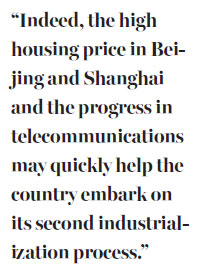Breaking from ultra-megacity centricity
Updated: 2016-09-16 07:10
By Ed Zhang(China Daily Europe)
|
|||||||||
With property prices still rising in major cities, we need more centers where resources are efficiently integrated
Since first being introduced in 2010, restrictions on residential property purchases have spread from first-tier cities - Beijing, Shanghai, Shenzhen and Guangzhou - to some second-tier cities.
Nanjing, capital of Jiangsu province, and Xiamen, a large city in Fujian province, recently joined the pack with restrictions on home ownership.
Terms vary but a basic line is to deny ownership to people without local hukou (resident registration), and sometimes to limit one family to one new property.
This is against the backdrop that, for the past few months, investors haven't found many worthy targets, while most companies report that doing business is getting harder than ever.

People parked a lot of money in China when overseas opportunities also looked limited, such as when people were talking about an interest rate hike in the United States.
Of all the businesses in the world, nothing is more paradoxical than the Chinese housing market. As it were, housing is the No 1 engine to sustain economic growth in developed nations. In China, if it's seen as part of the nation's unprecedented transition into a society dominated by city dwellers, along with all the matching urban infrastructure, it can keep providing good growth momentum for half a century to come.
The problem is, such an important industry's development has been imbalanced, so much so that the government has adopted as many restrictions as possible to prevent urban sprawl in the favorite destinations for migrants.
Beijing and Shanghai, which boast the best social security systems and services of all Chinese cities, each has up to 30 million residents in their metro area. The nation's best universities, as well as the largest Chinese and foreign corporations and technology labs, have attracted the best human capital to just a few of its largest cities.
This is why the restrictions have worked so poorly in the past few years.
Ambitious young people have kept coming to the cities they select, only to find the per-square-meter price has been jacked up to more than their starting salary by those who, despite the restrictions, still have managed to buy homes as investments (sometimes by faking a divorce or registering a property under a relative's name).
Even in some of Beijing's suburban areas prices of the best residential units exceed 20,000 yuan ($2,900; 2,600 euros) per square meter. In spots with more-convenient connections to the city's business districts, a unit price of 80,000 yuan is common, despite often hazardous outdoor air quality and daily traffic congestion.
This unhealthy dilemma, namely unfriendly living conditions, facing the nation's best young professionals used to be thought of as an inescapable situation, a problem with no solution, because in no other city can they find the kind of culture and work environment as in a few large cities.

For a long period, smaller cities were only busy enlisting overseas investors in simple processing factories. Central government officials could only imagine that the existing large cities would somehow branch out with satellite towns or connect to some nearby towns, to form what they call city groups, mirroring the reality of today's Pearl River Delta in Guangdong province.
City groups have problems, too, such as Shanghai and the rest of the Yangtze River Delta, or the area comprising Beijing, Tianjin and Hebei province. They belong to different administrative jurisdictions and can never closely integrate into a larger system.
However, thanks in part to the increasing capacity of the internet, things are beginning to change.
Some smaller cities, seeking to transition from a few manufacturing activities to more diverse businesses, are eager to attract young professionals and nurture startups in new technologies.
Most of these are in coastal provinces. They are divided into two types: one is a simpler combination of traditional manufacturing and e-commerce; the other is a more sophisticated integration of old business and new technology.
A recent list of China's top 10 e-commerce county towns included Tongxiang, Wenling, Tiantai and Yongkang in Zhejiang province; Shishi and Jinjiang in Fujian province; Changshu and Haimen in Jiangsu province; Puning in Guangdong; and Baigou in Hebei province. They are of the first type.
A friend of mine, who returned after graduate studies at the Massachusetts Institute of Technology, is now helping Shaoxing, a textile town in Zhejiang, to build big data services. That is likely to grow into the second type.
Indeed, the high housing prices in Beijing and Shanghai and the progress in telecommunications may quickly help the country embark on its second industrialization process. It must be led by cities where all resources efficiently integrate, rather than cities with only the most-expensive physical goods.
The author is an editor-at-large of China Daily. Contact the writer at edzhang@chinadaily.com.cn
(China Daily European Weekly 09/16/2016 page11)
Today's Top News
UK gives Hinkley Point nuclear power green light
Hillary Clinton remains healthy: doctor
UK confirms Hinkley project with 'new agreement'
Despite big deals, data shows less M&As after Brexit
New plan for grammar schools welcomed by Chinese
Moscow denies involvement in hacker attacks on WADA
EU should stay strong, stable and united: Tusk
Cameron to quit as MP; by-election triggered
Hot Topics
Lunar probe , China growth forecasts, Emission rules get tougher, China seen through 'colored lens', International board,
Editor's Picks

|

|

|

|

|

|







